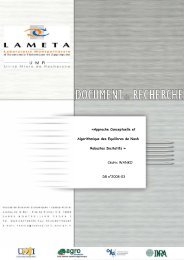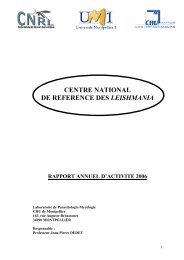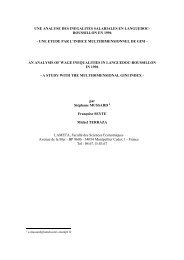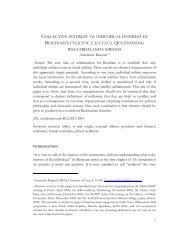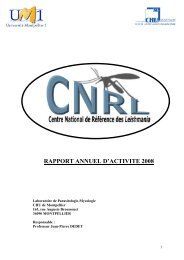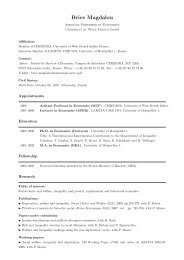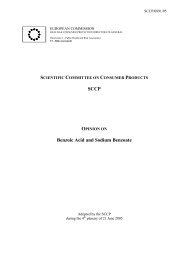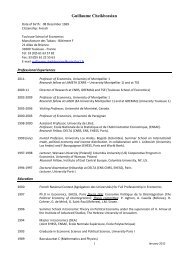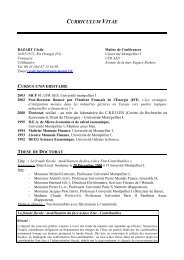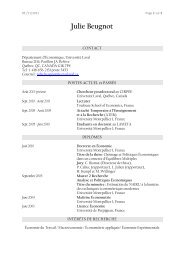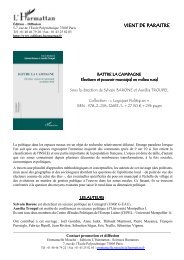à plusieurs voix. ce que les entretiens collectifs in situ peuvent ...
à plusieurs voix. ce que les entretiens collectifs in situ peuvent ...
à plusieurs voix. ce que les entretiens collectifs in situ peuvent ...
You also want an ePaper? Increase the reach of your titles
YUMPU automatically turns print PDFs into web optimized ePapers that Google loves.
Cél<strong>in</strong>e BRACONNIERDocument téléchargé depuis www.cairn.<strong>in</strong>fo - univ_montp1 - - 193.51.157.40 - 12/03/2012 10h32. © OphrysClanché F., 2003. – « La participation électorale au pr<strong>in</strong>temps 2002. De plus en plus de votants<strong>in</strong>termittents », Insee première, 877.Clausen A. R., 1968-1969. – « Response validity : vote report », The public op<strong>in</strong>ion quarterly, 32, 4pp. 588-606.Darras É., 2006. – « Le pouvoir de la télévision ? Sornettes, vieil<strong>les</strong> lunes et nouvel<strong>les</strong> approches »dans A. Cohen, B. Lacroix, P. Riutort (dirs.), Les formes de l’activité politi<strong>que</strong>. Élémentsd’analyse sociologi<strong>que</strong>, XVIII e -XX e siècle, Paris, Presses Universitaires de Fran<strong>ce</strong>, pp. 457-484.Desantis A. D., 2003. – « A couple of White guys sitt<strong>in</strong>g around talk<strong>in</strong>g. The collectiverationalization of cigar smokers », Journal of contemporary ethnography, 32, 4, pp. 432-466.Dogan M., 1965. – « Le vote ouvrier en Fran<strong>ce</strong> : analyse écologi<strong>que</strong> des élections de 1962 », Revuefrançaise de sociologie, 6, 4, pp. 435-471.Dogan M., Rokkan S., 1969. – « Multivariate analysis <strong>in</strong> political ecology » dans M. Dogan,S. Rokkan (eds.), Quantitative ecological analysis <strong>in</strong> the social scien<strong>ce</strong>s, Cambridge (MA),The MIT Press, pp. 233-298.Duchesne S., Haegel F., 2008. – L’enquête et ses méthodes. L’entretien collectif, Paris, ArmandCol<strong>in</strong>.Eliasoph N., 1998. – Avoid<strong>in</strong>g politics. How Americans produ<strong>ce</strong> apathy <strong>in</strong> everyday life, Cambridge,Cambridge University Press.F<strong>in</strong>ifter A. W., 1974. – « The friendship group as a protective environment for political deviants »,The American political scien<strong>ce</strong> review, 68, 2, pp. 607-625.Gamson W. A., 1992. – Talk<strong>in</strong>g politics, Cambridge, Cambridge University Press.Garrigou A., 1988. – « Le secret de l’isoloir », Actes de la recherche en scien<strong>ce</strong>s socia<strong>les</strong>, 71-72,pp. 22-45.Gaxie D., 2002. – « Appréhensions du politi<strong>que</strong> et mobilisation des expérien<strong>ce</strong>s socia<strong>les</strong> », Revuefrançaise de scien<strong>ce</strong> politi<strong>que</strong>, 52, 2, pp. 145-178.Goulet V., 2010. – Médias et classes populaires. Les usages ord<strong>in</strong>aires des <strong>in</strong>formations, Paris,Ina Éditions.Haegel F., Garcia G., 2011. – « Les enquêtés disent-ils toujours la même chose ? Concordan<strong>ce</strong>s etdiscordan<strong>ce</strong>s entre <strong>les</strong> réponses à un <strong>que</strong>stionnaire et <strong>les</strong> <strong>in</strong>terventions dans un entretiencollectif », Revue française de scien<strong>ce</strong> politi<strong>que</strong>, 61, 3, pp. 483-511.Harrop M., Heath A., Openshaw S., 1992. – « Does neighbourhood <strong>in</strong>fluen<strong>ce</strong> vot<strong>in</strong>g behavior – andwhy ? » dans I. Crewe, P. Norris, D. Denver, D. Broughton (eds.), British elections and partiesyearbook 1991, London, Harvester Wheatsheaf, pp. 103-120.Hirschman A. O., 1970. – Exit, voi<strong>ce</strong>, and loyalty. Responses to decl<strong>in</strong>e <strong>in</strong> firms, organizations, andStates, Cambridge (MA), Harvard University Press.Hoggart R., [1957] 1970. – La culture du pauvre. Étude sur le style de vie des classes populairesen Angleterre, Paris, Éditions de M<strong>in</strong>uit.Hollander J. A., 2004. – « The social contexts of focus groups », Journal of contemporaryethnography, 33, 5, pp. 602-637.Johnston R., Jones K., Propper C., Sarker R., Burgess S., Bolster A., 2005. – « A miss<strong>in</strong>g level <strong>in</strong>the analyses of British vot<strong>in</strong>g behavior : the household as context as shown by analyses of a1992-1997 longitud<strong>in</strong>al survey », Electoral studies, 24, 2, pp. 201-225.Johnston R., Pattie C., 2006. – Putt<strong>in</strong>g voters <strong>in</strong> their pla<strong>ce</strong>. Geography and elections <strong>in</strong> GreatBrita<strong>in</strong>, Oxford, Oxford University Press.Johnston R. J., Pattie C. J., Dorl<strong>in</strong>g D. F. L., MacAllister I., Tunstall H., Rossiter D. J., 2001. –« Hous<strong>in</strong>g tenure, local context, scale and vot<strong>in</strong>g <strong>in</strong> England and Wa<strong>les</strong>, 1997 », Electoral studies,20, 2, pp. 195-216.Johnston R., Propper C., Burgess S., Sarker R., Bolster A., Jones K., 2005. – « Spatial scale andthe neigbourhood effect : mult<strong>in</strong>omial models of vot<strong>in</strong>g at two re<strong>ce</strong>nt British general elections »,British journal of political scien<strong>ce</strong>, 35, 3, pp. 487-514.91Document téléchargé depuis www.cairn.<strong>in</strong>fo - univ_montp1 - - 193.51.157.40 - 12/03/2012 10h32. © Ophrys



